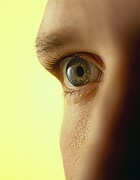- Navigating Your Midlife Crisis: Embracing New Possibilities
- City Raccoons Showing Signs of Domestication
- Mapping the Exposome: Science Broadens Focus to Environmental Disease Triggers
- One Week Less on Social Media Linked to Better Mental Health
- Your Brain Changes in Stages as You Age, Study Finds
- Some Suicide Victims Show No Typical Warning Signs, Study Finds
- ByHeart Formula Faces Lawsuits After Babies Sickened With Botulism
- Switch to Vegan Diet Could Cut Your Greenhouse Gas Emissions in Half
- Regular Bedtime Does Wonders for Blood Pressure
- Dining Alone Could Mean Worse Nutrition for Seniors
Eye Tracking May Help to Spot Concussions Quickly


A new eye-tracking method might help determine the severity of concussions, researchers report.
They said the simple approach can be used in emergency departments and, perhaps one day, on the sidelines at sporting events.
“Concussion is a condition that has been plagued by the lack of an objective diagnostic tool, which in turn has helped drive confusion and fears among those affected and their families,” said lead investigator Dr. Uzma Samadani. She is an assistant professor in the departments of neurosurgery, neuroscience and physiology at NYU Langone Medical Center in New York City.
“Our new eye-tracking methodology may be the missing piece to help better diagnose concussion severity, enable testing of diagnostics and therapeutics, and help assess recovery, such as when a patient can safely return to work following a head injury,” she explained in an NYU news release.
According to researchers, it’s believed that up to 90 percent of patients with concussions or blast injuries have eye movement problems. But the current method of assessing eye movement is asking a patient to track a doctor’s finger, Samadani said.
The new method was originally developed by Samadani and her colleagues to assess eye movement in U.S. military personnel believed to have concussion or other types of brain injuries.
The researchers compared 75 trauma injury patients and a control group of 64 healthy people. The movements of the participants’ pupils were tracked while they watched a music video for a few minutes.
Thirteen trauma patients who hit their heads and had CT scans showing new brain damage, and 39 trauma patients who hit their heads and had normal CT scans, were much less able to coordinate their eye movements than trauma patients who hadn’t hit their heads and those in the control group.
The more severe the concussion, the worse a patient’s eye movement problems, according to the study. Results were published online Jan. 29 in the Journal of Neurotrauma.
Dr. M. Sean Grady, chair of the neurosurgery department at the University of Pennsylvania’s Perelman School of Medicine in Philadelphia, said, “The importance of this study is that it establishes a reliable test and a ‘biological’ marker for detecting concussion.” He was not involved in the study.
“Since concussion can occur without loss of consciousness, this can be particularly important in sideline evaluations in athletics or in military settings where individuals are highly motivated to return to activity and may minimize their symptoms. More work is needed to establish its sensitivity and specificity, but it is very promising,” Grady said.
More information
The American Academy of Family Physicians has more about concussion.
Source: HealthDay
Copyright © 2025 HealthDay. All rights reserved.










